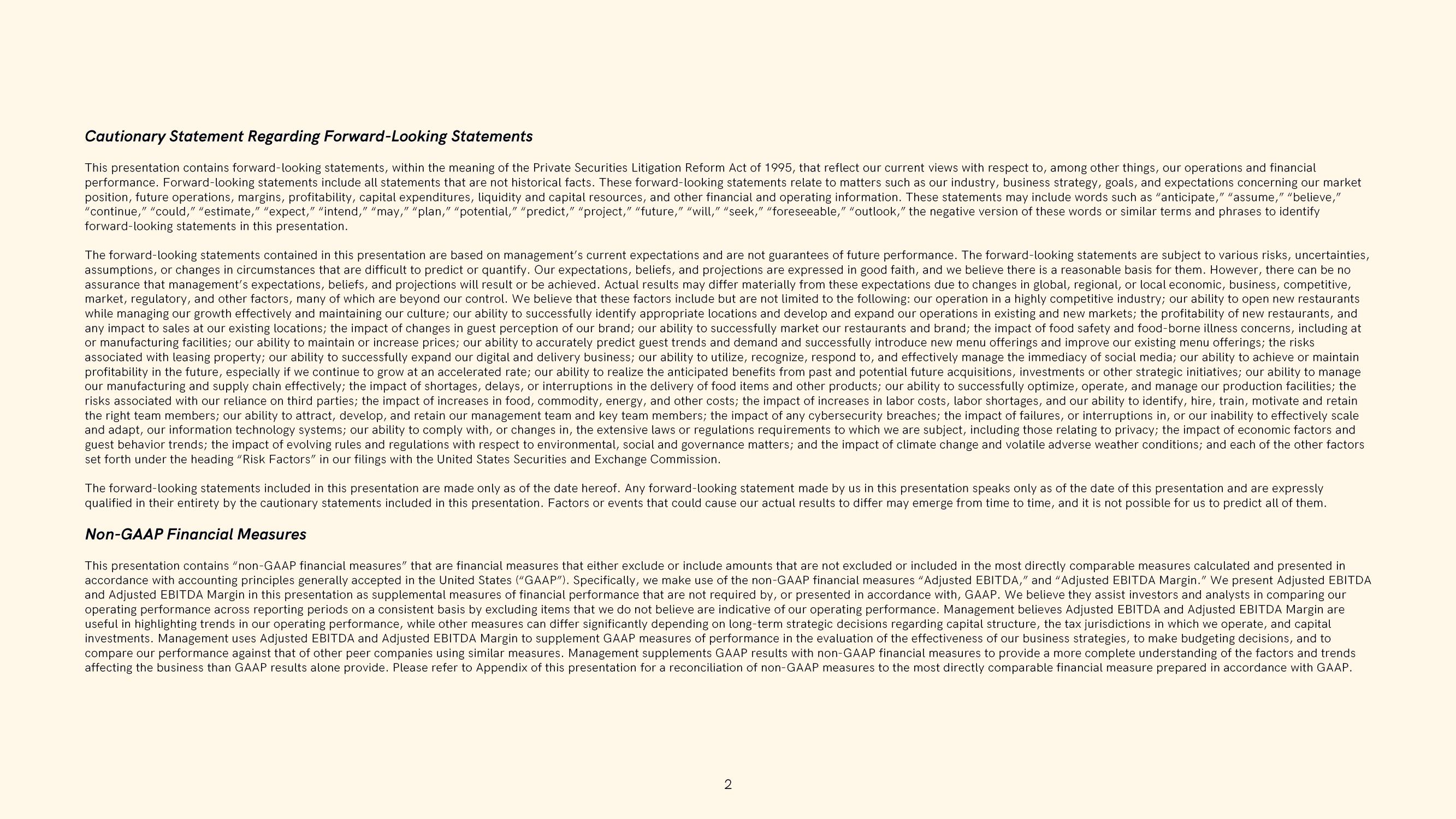CAVA Results Presentation Deck
Cautionary Statement Regarding Forward-Looking Statements
This presentation contains forward-looking statements, within the meaning of the Private Securities Litigation Reform Act of 1995, that reflect our current views with respect to, among other things, our operations and financial
performance. Forward-looking statements include all statements that are not historical facts. These forward-looking statements relate to matters such as our industry, business strategy, goals, and expectations concerning our market
position, future operations, margins, profitability, capital expenditures, liquidity and capital resources, and other financial and operating information. These statements may include words such as "anticipate," "assume," "believe,"
"continue," "could," "estimate," "expect," "intend," "may," "plan," "potential," "predict," "project," "future," "will," "seek," "foreseeable," "outlook," the negative version of these words or similar terms and phrases to identify
forward-looking statements in this presentation.
The forward-looking statements contained in this presentation are based on management's current expectations and are not guarantees of future performance. The forward-looking statements are subject to various risks, uncertainties,
assumptions, or changes in circumstances that are difficult to predict or quantify. Our expectations, beliefs, and projections are expressed in good faith, and we believe there is a reasonable basis for them. However, there can be no
assurance that management's expectations, beliefs, and projections will result or be achieved. Actual results may differ materially from these expectations due to changes in global, regional, or local economic, business, competitive,
market, regulatory, and other factors, many of which are beyond our control. We believe that these factors include but are not limited to the following: our operation in a highly competitive industry; our ability to open new restaurants
while managing our growth effectively and maintaining our culture; our ability to successfully identify appropriate locations and develop and expand our operations in existing and new markets; the profitability of new restaurants, and
any impact to sales at our existing locations; the impact of changes in guest perception of our brand; our ability to successfully market our restaurants and brand; the impact of food safety and food-borne illness concerns, including at
or manufacturing facilities; our ability to maintain or increase prices; our ability to accurately predict guest trends and demand and successfully introduce new menu offerings and improve our existing menu offerings; the risks
associated with leasing property; our ability to successfully expand our digital and delivery business; our ability to utilize, recognize, respond to, and effectively manage the immediacy of social media; our ability to achieve or maintain
profitability in the future, especially if we continue to grow at an accelerated rate; our ability to realize the anticipated benefits from past and potential future acquisitions, investments or other strategic initiatives; our ability to manage
our manufacturing and supply chain effectively; the impact of shortages, delays, or interruptions in the delivery of food items and other products; our ability to successfully optimize, operate, and manage our production facilities; the
risks associated with our reliance on third parties; the impact of increases in food, commodity, energy, and other costs; the impact of increases in labor costs, labor shortages, and our ability to identify, hire, train, motivate and retain
the right team members; our ability to attract, develop, and retain our management team and key team members; the impact of any cybersecurity breaches; the impact of failures, or interruptions in, or our inability to effectively scale
and adapt, our information technology systems; our ability to comply with, or changes in, the extensive laws or regulations requirements to which we are subject, including those relating to privacy; the impact of economic factors and
guest behavior trends; the impact of evolving rules and regulations with respect to environmental, social and governance matters; and the impact of climate change and volatile adverse weather conditions; and each of the other factors
set forth under the heading "Risk Factors" in our filings with the United States Securities and Exchange Commission.
The forward-looking statements included in this presentation are made only as of the date hereof. Any forward-looking statement made by us in this presentation speaks only as of the date of this presentation and are expressly
qualified in their entirety by the cautionary statements included in this presentation. Factors or events that could cause our actual results to differ may emerge from time to time, and it is not possible for us to predict all of them.
Non-GAAP Financial Measures
This presentation contains "non-GAAP financial measures" that are financial measures that either exclude or include amounts that are not excluded or included in the most directly comparable measures calculated and presented in
accordance with accounting principles generally accepted in the United States ("GAAP"). Specifically, we make use of the non-GAAP financial measures "Adjusted EBITDA," and "Adjusted EBITDA Margin." We present Adjusted EBITDA
and Adjusted EBITDA Margin in this presentation as supplemental measures of financial performance that are not required by, or presented in accordance with, GAAP. We believe they assist investors and analysts in comparing our
operating performance across reporting periods on a consistent basis by excluding items that we do not believe are indicative of our operating performance. Management believes Adjusted EBITDA and Adjusted EBITDA Margin are
useful in highlighting trends in our operating performance, while other measures can differ significantly depending on long-term strategic decisions regarding capital structure, the tax jurisdictions in which we operate, and capital
investments. Management uses Adjusted EBITDA and Adjusted EBITDA Margin to supplement GAAP measures of performance in the evaluation of the effectiveness of our business strategies, to make budgeting decisions, and to
compare our performance against that of other peer companies using similar measures. Management supplements GAAP results with non-GAAP financial measures to provide a more complete understanding of the factors and trends
affecting the business than GAAP results alone provide. Please refer to Appendix of this presentation for a reconciliation of non-GAAP measures to the most directly comparable financial measure prepared in accordance with GAAP.
2View entire presentation